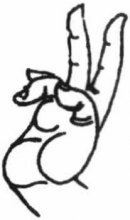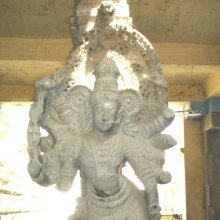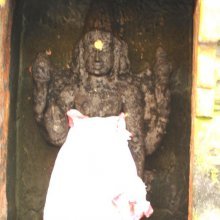Kartarimukha, Kartarīmukha, Kartari-mukha: 10 definitions
Introduction:
Kartarimukha means something in Hinduism, Sanskrit. If you want to know the exact meaning, history, etymology or English translation of this term then check out the descriptions on this page. Add your comment or reference to a book if you want to contribute to this summary article.
Images (photo gallery)
In Hinduism
Natyashastra (theatrics and dramaturgy)
Source: Wisdom Library: Nāṭya-śāstraKartarīmukha (कर्तरीमुख, “scissors’ blades”) refers to a gesture (āṅgika) made with a ‘single hand’ (asaṃyuta), according to the Nāṭyaśāstra chapter 8. The hands (hasta) form a part of the human body which represents one of the six major limbs (aṅga) used in dramatic performance. With these limbs are made the various gestures (āṅgika), which form a part of the histrionic representation (abhinaya).
(Instructions of Kartarīmukha): The forefinger of the Tripatāka hand is to bend backwards.
(Uses of Kartarīmukha): This [hand with its fingers] pointing downwards will represent showing the way, decorating the feet or dying them, and the crawling [of babies]. With fingers pointing upwards it will represent biting, horn and letters. And when the fingers in it are turned differently (i.e. the middle finger is bent backwards) it will represent falling down, death, transgression, reversion, cogitation and putting [anything] in trust.
Source: archive.org: The mirror of gesture (abhinaya-darpana)One of the Twenty-eight Single Hands (hasta):—Kartarī-mukha (arrow shaft face): in the same hand, the forefingerand little finger are outspread. Usage: separation of woman and man, opposition or overturning, stealing, the cornerof the eye, death, disagreement, lightning, sleeping alone, falling, a creeper.
According to another book: the forefinger of the Tripatāka hand is out(-spread). Once upon a time, the sages say, Śaśāṅkaśekhara (Śiva), set out to slay Jaḍandhara; he drew a circle round the centre of the earth with his forefinger, and that is the origin of the Kartarī-mukha hand. It originates from Śiva, itssage is Parjaniya, its race Kṣattriya, its colour coppery, its patrondeity Cakrapāṇi (Viṣṇu). Usage: red paint for the feet (padā-laktaka), drawing patterns on the body, yearning of separated husband and wife, overturning or opposition, Mādhava, lightning, sleeping alone, buffalo, deer, fly-whisk, hill-top, elephant,bull, cow, thick coil of hair, Kṣattriya caste, copper colour, scissors, tower.
Note: A fuller description of the Kartarī-mukha hand is quoted by T. A. Gopinatha Rao, from an unnamed source, in “Hindu Iconography,” 1914, p. xxxi, where it is stated that it is used for holding attributes such as the conchand discus; and also that the thumb and third finger should meet near the middle of the palms. The hands of images conform to this rule in most cases, but not invariably. Most likely there exists some confusion of Kartarī-mukha and Mayura hands. Our figure shows the Kartarī-mukha hand according to the text description.
Source: Shodhganga: Elements of Art and Architecture in the Trtiyakhanda of the Visnudharmottarapurana (natya)Kartarīmukha (कर्तरीमुख) refers to one of the twenty-two Asaṃyuktahastas or “single hand gestures” (in Indian Dramas), according to the Viṣṇudharmottarapurāṇa, an ancient Sanskrit text which (being encyclopedic in nature) deals with a variety of cultural topics such as arts, architecture, music, grammar and astronomy.—The hasta-mudrās (lit. “hand-gestures”) are very essential to denote some particular action or state in dancing and these mudrās are formed with the help of hands and fingers.—The word kartarī means scissor and along with the word mukha, it means mouth of the scissor. The Viṣṇudharmottarapurāṇa suggests that in the kartarīmukha-hasta, the hand should be in tripatāka-hasta and the forefinger is kept in the back of the middle finger. Here the point is to be noted that, though forefinger is kept in the back of the middle finger in kartarīmukha-hasta, the forefinger should not touch the middle finger. The inclusion of the word avalokinī in the definition of kartarīmukha-hasta proposed by the Viṣṇudharmottarapurāṇa indicates it. Abhinavagupta clearly explains it in his book. Moreover, when forefinger is kept in the back of the middle finger and when it does not touch the middle finger, it literary looks like the mouth of a scissor. But the view point of the Abhinayadarpaṇa is totally different from that of the Viṣṇudharmottarapurāṇa in this regard.
According to the Abhinayadarpaṇa, only two fingers i.e., forefinger and the ring finger should be spread and strainghtened in kartarīmukha-hasta and the rest of the fingers should be bent. So, it can be said that, according to the Abhinayadarpaṇa, the middle finger is bent in kartarīmukha-hasta where as in the Viṣṇudharmottarapurāṇa, it remains completely straightened. Some activities like traveling, cutting and falling are projected with this hand gesture.

Natyashastra (नाट्यशास्त्र, nāṭyaśāstra) refers to both the ancient Indian tradition (shastra) of performing arts, (natya—theatrics, drama, dance, music), as well as the name of a Sanskrit work dealing with these subjects. It also teaches the rules for composing Dramatic plays (nataka), construction and performance of Theater, and Poetic works (kavya).
Shilpashastra (iconography)
Source: Shodhganga: The significance of the mūla-beras (śilpa)Kartarīmukha (कर्तरीमुख) or Kartarīmukhahasta refers to “scissors-like” and represents one of the twenty-four gestures with a single hand, as defined according to texts dealing with śilpa (arts and crafs), known as śilpaśāstras.—Accordingly, pratimā-lakṣaṇa (body postures of the icons) is comprised of hand gestures (hasta, mudrā or kai-amaiti), stances/poses (āsanas) and inflexions of the body (bhaṅgas). There are thirty-two types of hands [viz., kartarīmukha-hasta] classified into two major groups known as tolirkai (functional and expressive gestures) and elirkai (graceful posture of the hand).
Source: Shodhganga: Vaisnava Agamas And Visnu ImagesKartarīmukha (कर्तरीमुख) or Kartarīmukhahasta refers to one of the various hand-poses (hastas or mudrās) defined in treatises such as the Pāñcarātra, Pādmasaṃhitā and Vaikhānasa-āgamas, extensively dealing with the technical features of temple art, iconography and architecture in Vaishnavism.—Kāśyapaśilpaśāstra (64.15-16a) prescribes that the ring finger and the thumb remain bent touching each other and press against the palm of the hand. The little finger is slightly bent. The index and middle fingers are stretched upwards, holding an attribute between the index and middle fingers in which index and ring fingers resemble open pair (mouth) of scissors (kartari). Generally, the backhands are represented with this gesture holding any attributes like cakra, śaṅkha, paraśu, padma, kamaṇḍalu, etc. in this hand gesture.
In this Kartarimukha gesture the tip of the middle finger stretched upward should be equal to the level of hikkā-sūtra. The distance between the maṇibandha (wrist) and the outer side of the upper part of arm is eight aṅgulas; the distance between uṣṇīṣa and śaṅkha/ cakra is twelve aṅgulas, and the elbow must be at the distance of six aṅgulas from the side part of mid-belly (madhya-udara), thus Marīci (Vimānārcanākalpa 22, p. 160) defines the position of the hand with kartarīmukha.
In few icons, the hand bears Kartarīmukha but śaṅkha and cakra are held in the fingers rather placed on the tip of tarjanī and madhyamā. In the icon of Viṣṇu from Olayakkunnam the kartarīmukha is differently u ed in which the śaṅkha and cakra appear as if they are placed on anāmikā and tarjanī. In the icon of Viṣṇu from Mangammalpuram, all the three fingers kaniṣṭikā, anāmikā and madhyamā are bent, tarjanī is straight and the flame of cakra remains between the tarjanī and aṅguṣṭha . In the icon of Palani, the palm of the kartarīmukha faces upwards, probably to adjust the pallava-mudrā in lower right hand holding a lotus. In the icon of Avidi, the kartarīmukha is created in a natural way i.e. the combination of kartarīmukha and three fingers to hold the tern of the śaṅkha and cakra as if holding the stem of lotus.

Shilpashastra (शिल्पशास्त्र, śilpaśāstra) represents the ancient Indian science (shastra) of creative arts (shilpa) such as sculpture, iconography and painting. Closely related to Vastushastra (architecture), they often share the same literature.
Languages of India and abroad
Sanskrit dictionary
Source: DDSA: The practical Sanskrit-English dictionaryKartarīmukha (कर्तरीमुख).—A particular position of the hands.
Derivable forms: kartarīmukhaḥ (कर्तरीमुखः).
Kartarīmukha is a Sanskrit compound consisting of the terms kartarī and mukha (मुख). See also (synonyms): kartarikāmukha.
Source: Cologne Digital Sanskrit Dictionaries: Monier-Williams Sanskrit-English DictionaryKartarīmukha (कर्तरीमुख):—[=kartarī-mukha] [from kartarī > karta] m. a particular position of the hands, [Purāṇa-sarvasva]
[Sanskrit to German]
Sanskrit, also spelled संस्कृतम् (saṃskṛtam), is an ancient language of India commonly seen as the grandmother of the Indo-European language family (even English!). Closely allied with Prakrit and Pali, Sanskrit is more exhaustive in both grammar and terms and has the most extensive collection of literature in the world, greatly surpassing its sister-languages Greek and Latin.
Kannada-English dictionary
Source: Alar: Kannada-English corpusKartarīmukha (ಕರ್ತರೀಮುಖ):—[noun] (dance.) a single hand gesture, bending the thumb and ring finger, extending the forefinger and middle finger one behind the other in the shape of a scissorś blades.
Kannada is a Dravidian language (as opposed to the Indo-European language family) mainly spoken in the southwestern region of India.
See also (Relevant definitions)
Partial matches: Kartari, Mukha.
Starts with: Kartarimukhahasta.
Full-text (+43): Hintala, Bhartribhratri, Kartari-svastika, Kartaryasya, Mayura, Kartarimukhahasta, Kartarikamukha, Mahishasuramardini, Indra, Parthasarathi, Arunacaleshvar, Hasta, Shrinivasa, Shiva, Hayagriva, Balasubrahmaṇya, Goumari, Ulagalantha Perumal, Nirakatu Perumal, Bhumivaraha.
Relevant text
Search found 4 books and stories containing Kartarimukha, Kartarīmukha, Kartari-mukha, Kartarī-mukha; (plurals include: Kartarimukhas, Kartarīmukhas, mukhas). You can also click to the full overview containing English textual excerpts. Below are direct links for the most relevant articles:
Vishnudharmottara Purana (Art and Architecture) (by Bhagyashree Sarma)
2. The Viṣṇudharmottara-purāṇa and the Indian Classical Dances < [Chapter 6 - Modern Relevance of Different Art Forms and Architecture]
2.2. Hand Postures (a): Asaṃyukta-hasta < [Chapter 3 - Drama and Dance]
Abhinaya-darpana (English) (by Ananda Coomaraswamy)
Plate VII - Hands of Images < [Plates]
Chapter 12 - Twenty-eighth Single Hands
Gati in Theory and Practice (by Dr. Sujatha Mohan)
Description of Gati as in Bharatārṇava < [Chapter 2 - Concept and technique of Gati]
Natyashastra (English) (by Bharata-muni)


